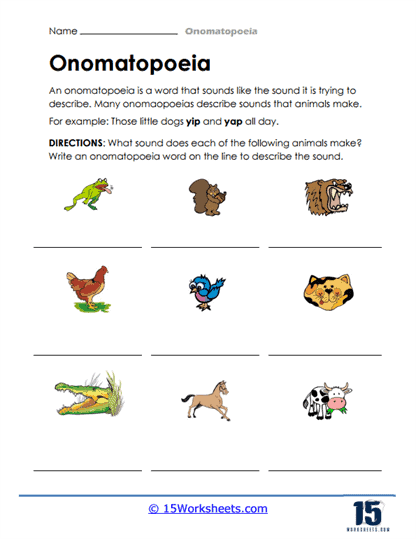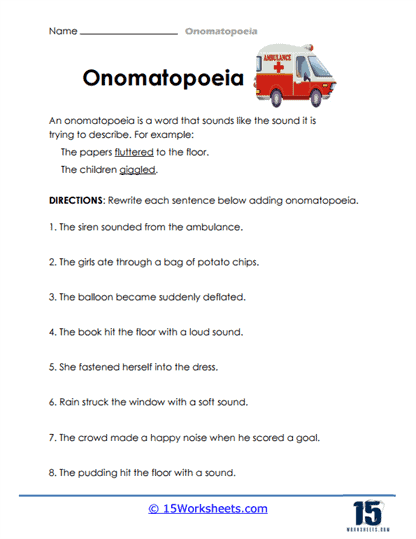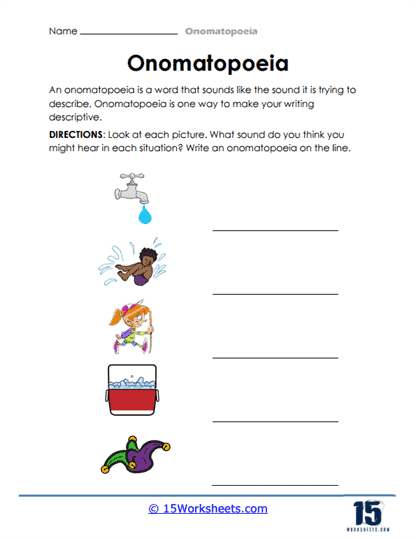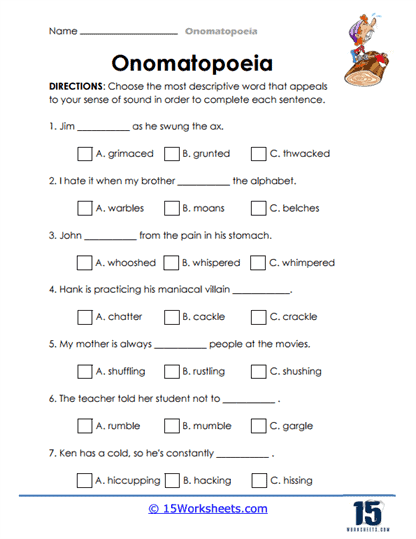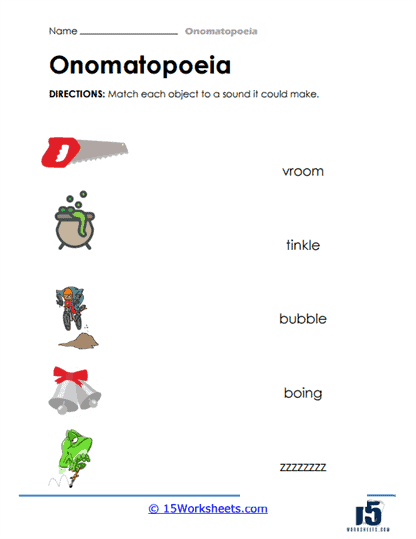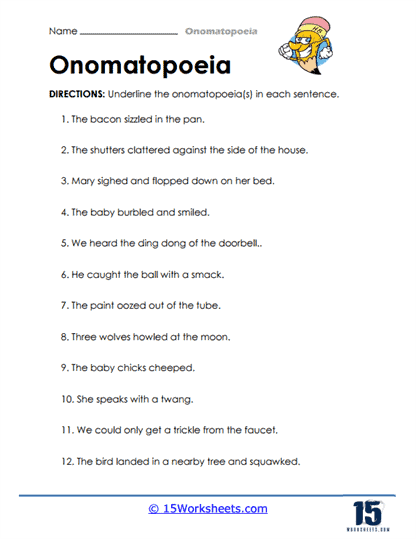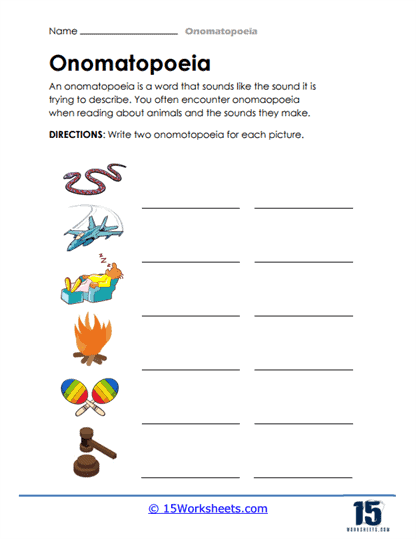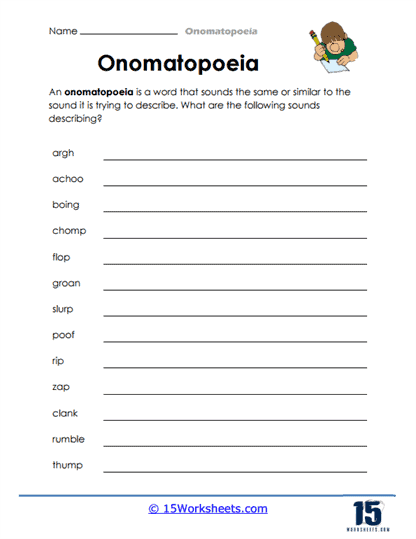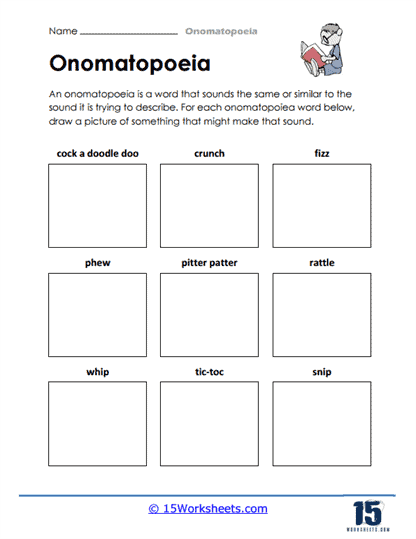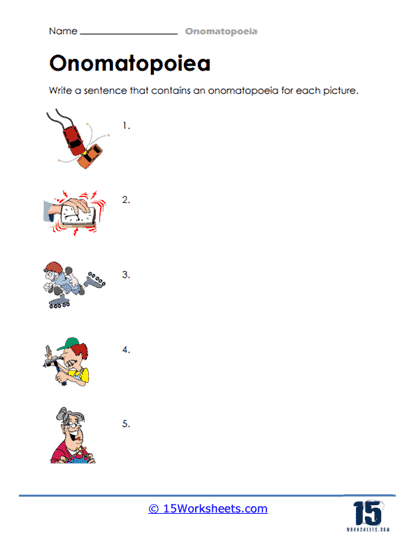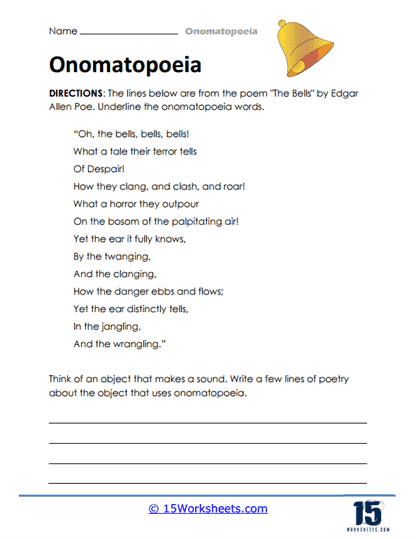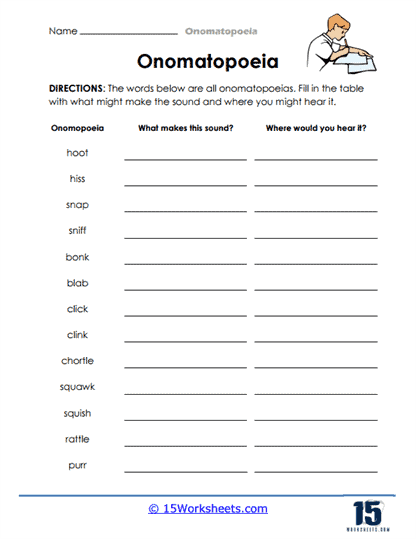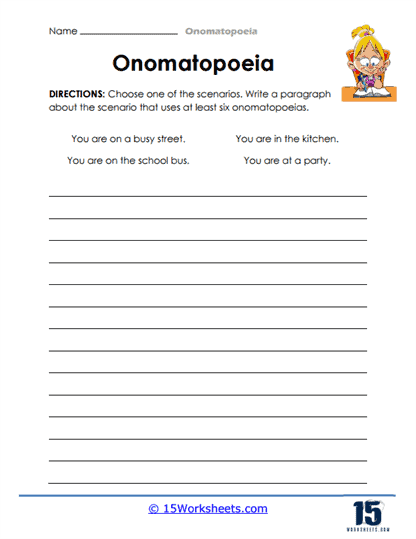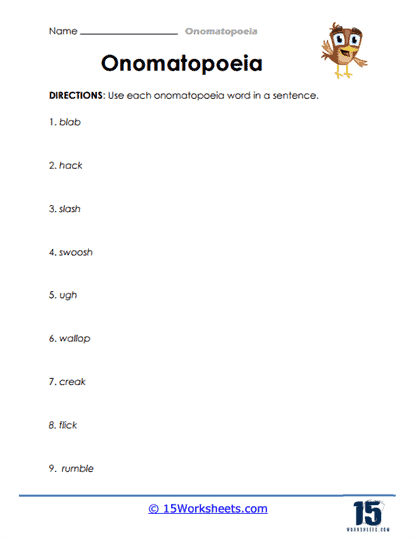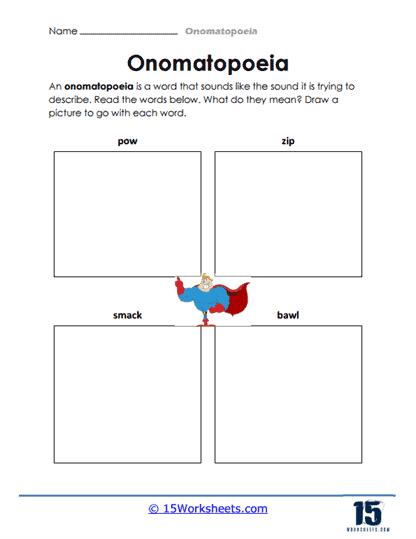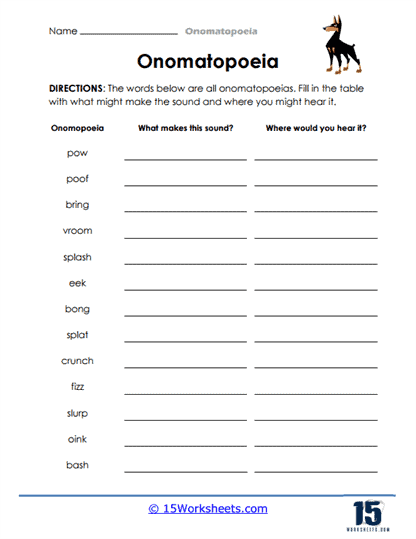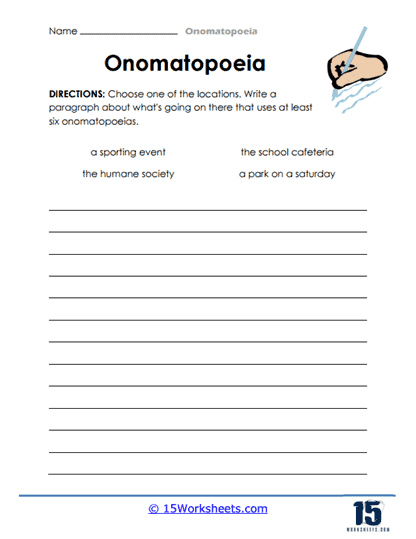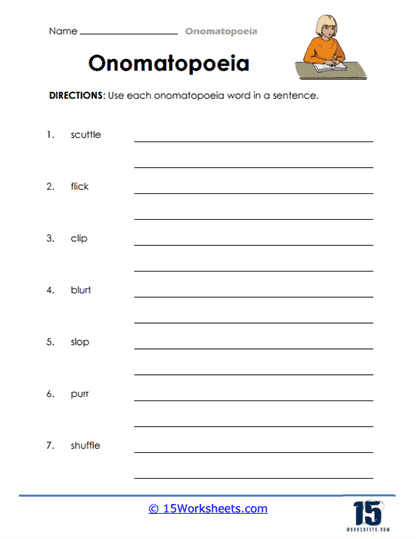Onomatopoeia Worksheets
About These 15 Worksheets
Onomatopoeia worksheets are powerful tools that offer a hands-on way to understand and practice the use of onomatopoeic words in language. Onomatopoeia, a unique figure of speech, breathes life into writing by imitating the sounds associated with the objects or actions they represent. These worksheets not only introduce the concept of onomatopoeia but also provide engaging and interactive exercises that allow learners to explore, identify, and incorporate these vivid words into their own writing.
To break down the concept of onomatopoeia, let’s start with the words themselves. Words like “buzz,” “hiss,” “sizzle,” and “crash” don’t just describe sounds-they evoke them. When you read or hear these words, you can almost hear the sounds they are mimicking. “Buzz” might bring to mind the steady hum of a bee, “hiss” the slithering sound of a snake, and “sizzle” the sharp, heated sound of something cooking in a pan. This quality of onomatopoeic words helps to create a more immersive and vivid reading experience, drawing readers closer to the action or scene being described.
Onomatopoeia worksheets offer a variety of exercises that support the development of this skill. For instance, one type of worksheet might focus on matching words with the sounds they represent. You might be given a list of common onomatopoeic words-like “crackle,” “clang,” or “slurp”-and asked to match them with pictures or descriptions of situations that produce those sounds. Such activities sharpen your ability to connect words to sensory experiences, making the abstract concept of sound in writing much more tangible.
Another approach featured in onomatopoeia worksheets is sentence-based exercises. Here, learners are presented with sentences or short paragraphs and tasked with identifying the onomatopoeic words embedded within. For example, in a sentence like “The thunder rumbled across the sky as the rain splattered against the window,” you would be asked to underline or circle the words “rumbled” and “splattered,” both of which mimic sounds. This method helps develop the skill of recognizing onomatopoeia in context, which is crucial for understanding its role in enhancing descriptive writing.
One of the key benefits of working with onomatopoeia worksheets is the improvement of descriptive writing. Descriptive writing thrives on the ability to paint a vivid picture in the reader’s mind, and onomatopoeic words are a valuable tool in achieving this. Consider the difference between writing “The fire made a noise” versus “The fire crackled and popped.” The latter not only tells the reader about the sound but allows them to hear it in their mind’s ear, enhancing the overall sensory experience of the text. By practicing with onomatopoeia worksheets, you learn to enrich your own writing with these kinds of vivid, sound-rich descriptions.
These types of worksheets go beyond simple recognition and use by integrating literary analysis. For example, a worksheet might feature a passage from a classic text, such as Robert Browning’s The Pied Piper of Hamelin, and ask students to identify the onomatopoeic words within the excerpt. In this case, students are not only improving their language arts skills by recognizing these words but are also engaging with the text on a deeper level. They learn to appreciate how authors use sound to create mood and atmosphere, contributing to the overall tone and impact of the piece.
Another engaging exercise found in these worksheets involves creativity. For instance, a worksheet might present students with a list of onomatopoeic words such as “fizz,” “whip,” and “crunch,” and ask them to draw an image representing what could make that sound. This type of activity appeals to visual and kinesthetic learners, blending auditory learning with creative expression. By making the connection between sound and imagery, students strengthen their ability to visualize and describe scenes more effectively.
Onomatopoeia worksheets also play a role in enhancing reading comprehension. By working through passages that include onomatopoeic words, students learn to identify these words in context and understand their function within a narrative. This helps readers not only enjoy the text on a sensory level but also analyze how authors use language to create a specific atmosphere. For example, the sound of a “crash” in a story might signal sudden action or chaos, while the gentle “rustle” of leaves could evoke a peaceful setting. Understanding this subtlety in word choice deepens a student’s ability to analyze and appreciate literature.
Another valuable aspect of onomatopoeia worksheets is the development of vocabulary. As students work with these sound-imitating words, they expand their descriptive word bank, which can be particularly beneficial in creative writing. By practicing with onomatopoeic words, students become more confident in their ability to use rich, specific language to convey sounds, actions, and feelings. This increased comfort with vocabulary improves their overall writing ability, as they are better equipped to choose the most effective words to create vivid, dynamic descriptions.
These worksheets cater to a wide range of learning styles. Some learners thrive in visual environments, while others prefer auditory or hands-on experiences. Onomatopoeia worksheets often combine these approaches, offering something for every type of learner. The inclusion of interactive activities, like drawing sounds or acting out onomatopoeic words, engages students in a multisensory learning experience. This holistic approach ensures that learners are not just memorizing words but truly understanding how onomatopoeia enhances language.
Why Do Authors Use Onomatopoeia In Their Work?
Authors use onomatopoeia in their work for several reasons:
Creating Vivid and Engaging Descriptions – Onomatopoeic words bring descriptions to life by imitating the sounds associated with the objects or actions being described. By using words like “buzz,” “crash,” or “whisper,” authors make their writing more vivid, engaging, and memorable. Onomatopoeia helps readers imagine and experience the sounds within the narrative, adding a sensory dimension to the text.
Adding Realism and Authenticity – Onomatopoeia adds a sense of realism and authenticity to the storytelling. By incorporating words that mimic sounds, authors create a closer connection between the readers and the events or environments being depicted. Onomatopoeia helps create a more immersive reading experience by simulating the sounds that would naturally occur in the described situations.
Evoking Emotions and Atmosphere – Onomatopoeic words can evoke specific emotions and set the desired atmosphere in a story. By using words that imitate sounds associated with emotions or specific situations, authors can elicit a desired response from the readers. For example, a sudden “crack” can create a tense or dramatic atmosphere, while a gentle “whisper” can evoke a sense of intimacy or secrecy.
Enhancing Sound Effects and Dialogue – Onomatopoeia is often used to enhance sound effects and dialogue. By employing words that imitate sounds, authors can depict sounds in a more dynamic and engaging manner. Onomatopoeic words can bring action sequences, environmental sounds, or character interactions to life, making them more vivid and realistic.
Adding Playfulness and Creativity – Onomatopoeia allows authors to infuse their writing with a sense of playfulness and creativity. By using words that imitate sounds, authors demonstrate their inventiveness and linguistic skills. Onomatopoeia provides an opportunity for wordplay, adding a touch of whimsy and imagination to the narrative.
Enriching Poetry and Rhythm – Onomatopoeic words are often used in poetry to create specific rhythms, sound patterns, or musical effects. By incorporating words that imitate sounds, poets can enhance the auditory quality of their work, making it more melodic, rhythmic, or expressive. Onomatopoeia adds a layer of beauty and musicality to the poetic language.

